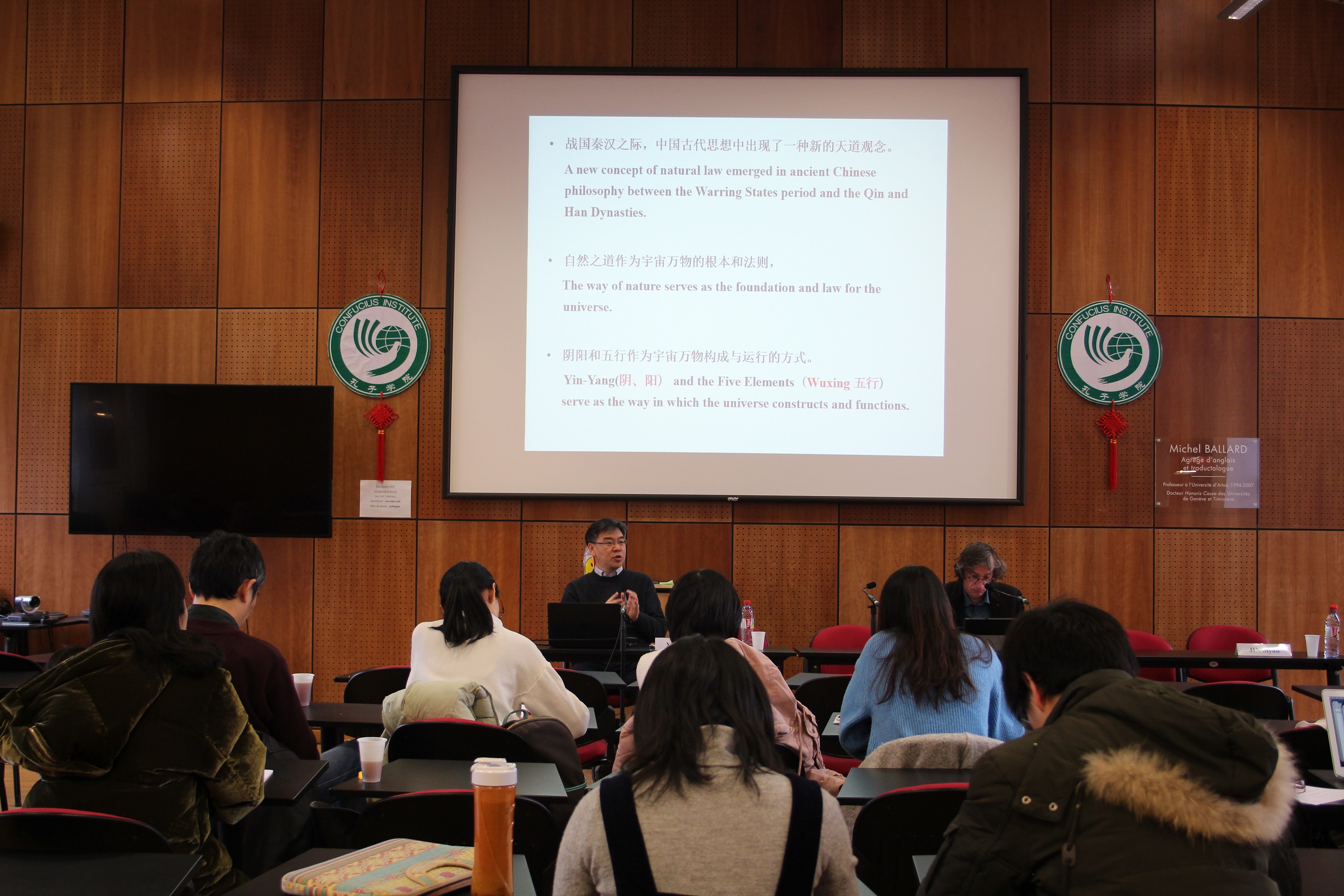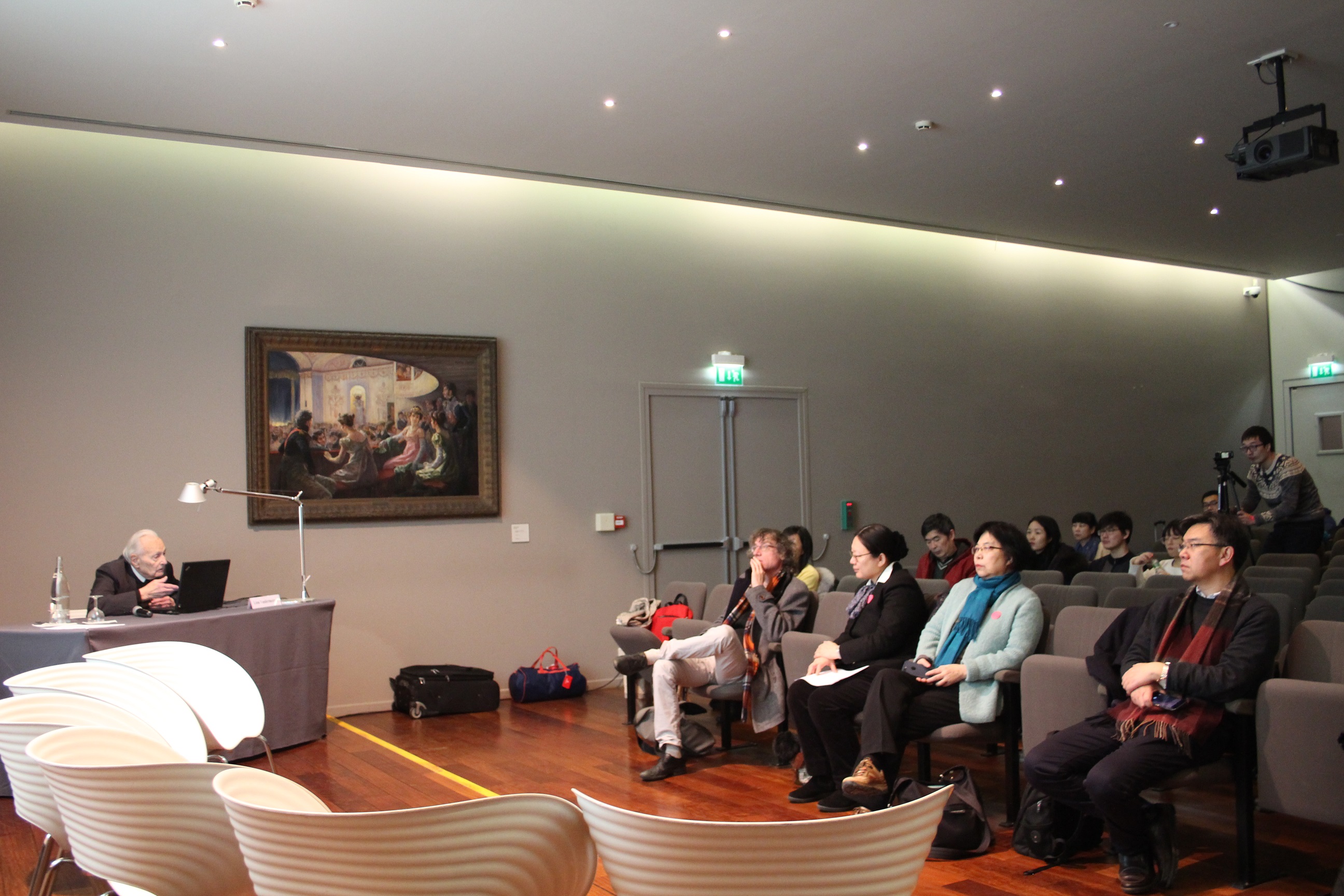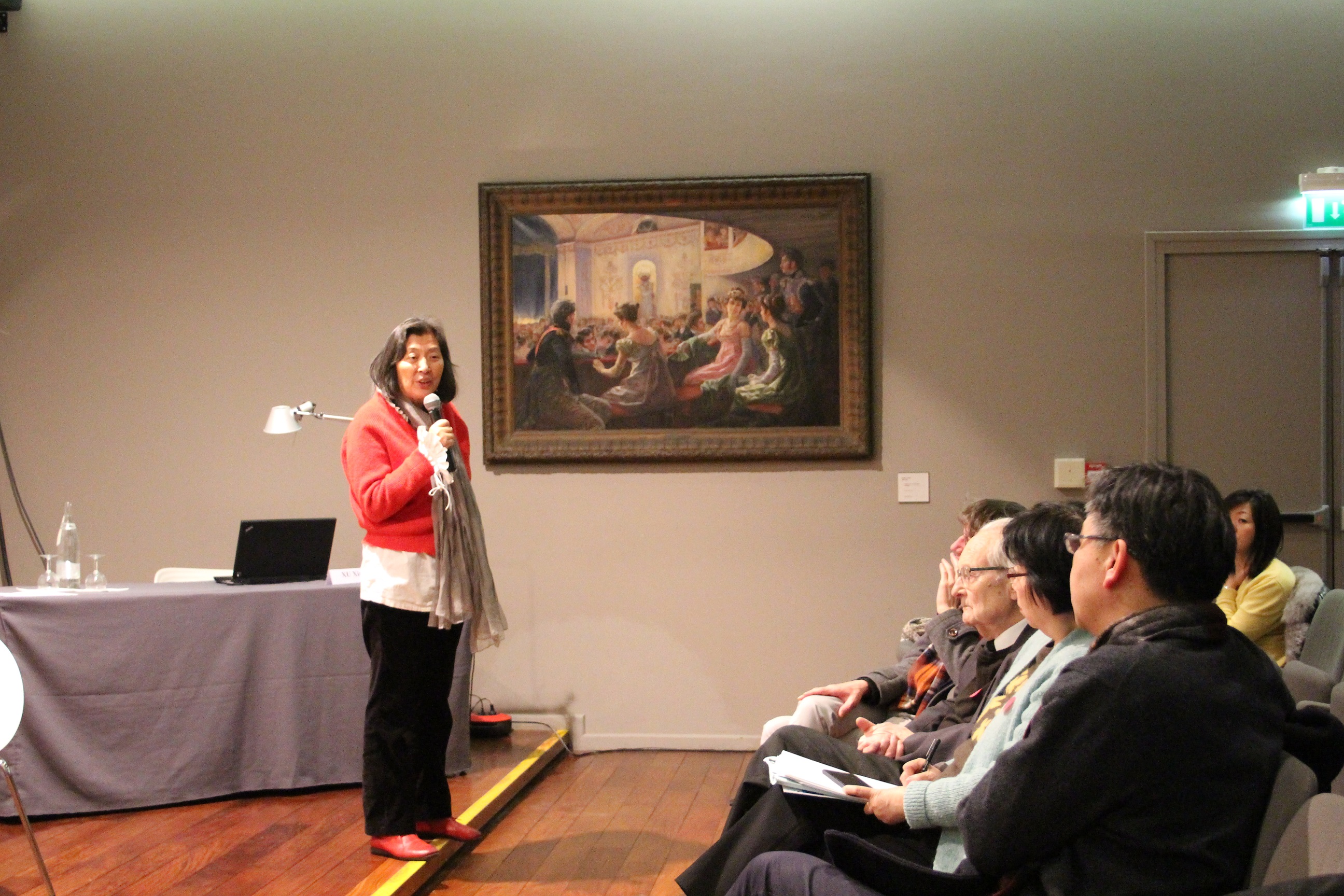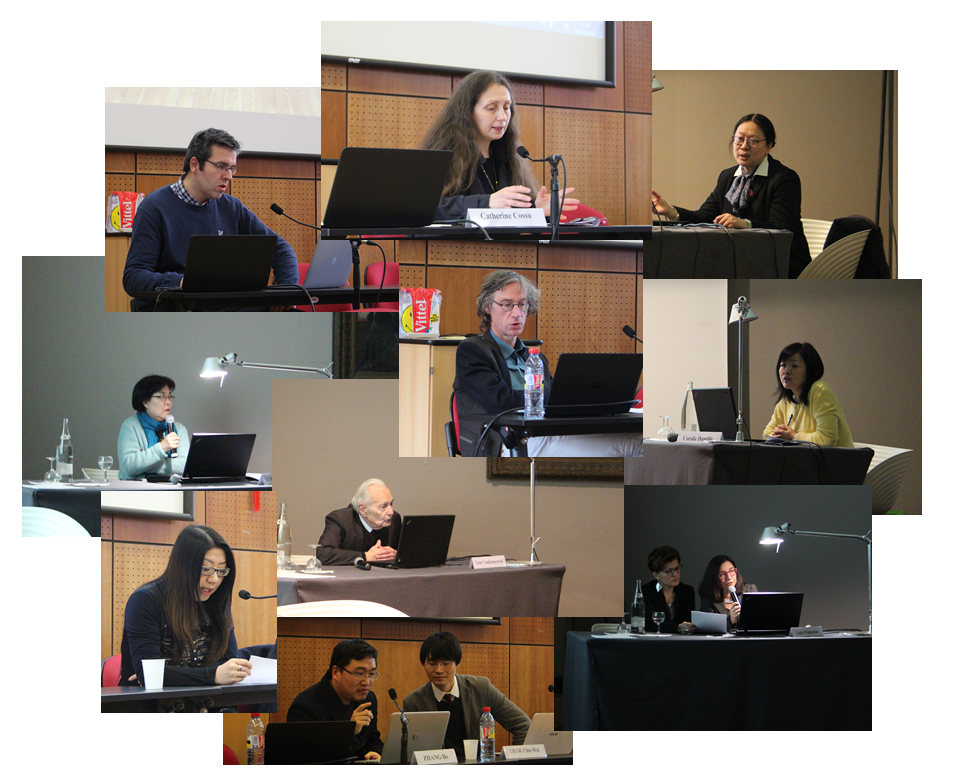法国阿尔多瓦大学孔子学院院长金丝燕教授、南京大学文学院院长徐兴无教授、比利时根特大学巴得胜(Bart Dessein)教授、法国著名汉学家汪德迈(Leon Vandermeersch)教授、里尔三大彭昌明教授、凯瑟琳·科苏(Catherine Cossu)、李小红、周晓珊、李月光、罗曼(Romain Lefebvre)、法国国家东方语言文化研究所路易莎·布鲁丹蒂诺(Luisa Prudentino)、瓦内萨·德努西奥(Vanessa Denuccio)等学者做了会议发言。金丝燕主持并翻译。阿尔多瓦大学校长玛蒙(Pasquale Mammone)教授与会。阿尔多瓦大学大学相关专业的博、硕研究生、本科生和当地各界人士参加了会议。
研讨会的第一天,金丝燕教授分析了诗与画即“我”在孤独中与宇宙的对话。凯瑟琳·科苏(Catherine Cossu)介绍了弗朗西斯科.桑索维诺(Francesco Sansovino)的作品“Sette libri di Satire(1560)”,以及这部作品对艺术的思考。李月光分析了女性文学如何从开始挣脱男性文学的束缚,发展到创作反映社会变化的独立作品,指出写作中女性意识还有发展空间和自我觉醒空间。巴得胜(Bart Dessein)通过禅会图,讲述了唐朝文学家、哲学家李翱向一代高僧问禅访道的逸事。罗曼(Romain Lefebvre)研究西夏壁画、建筑、雕塑、佛经版画和瓷制佛教用品,提出西夏艺术风格的形成受到中原汉文化的影响。
第二天的会议在在鲁贝“游泳池”——艺术与工业博物馆进行。汪德迈(Léon Vandermeersch)从汉字“美”和“文”出发,分析中国书法和水墨画的独特审美观。彭长明分析中西艺术创作中形而上的语言。周晓珊介绍中国著名翻译家傅雷先生的翻译观和艺术观。徐兴无通过“宇宙意识”的观念,分析中国古代诗歌宇宙意识的产生过程,解释诗歌的宇宙意识和“文学思维”。李晓红展示了形态各异的燃烧器和博山炉,提出无论是在东方还是西方,人们的信仰都是通过创造者(艺术家)的作品来实现的。路易莎·布鲁丹蒂诺(Luisa Prudentino)与瓦内萨·德努西奥(Vanessa Denuccio)从绘画和电影两个角度的对比,指出中西方艺术的差异。学者们就中西方艺术的异同、融合与文化转场问题展开讨论。
会后,与会者在阿尔多瓦孔子学院法方院长金丝燕教授和中方院长吴朝阳教授的带领下,参观了鲁贝(le Bar)画廊举办的释本如大师以“中国禅意绘画”为主题的中国画和书法展,研讨会在东西方艺术的丰富意境和可延展话题中结束。
(文/陈云云;图/林家驹 徐萌)
International Seminar “Purpose of Art - West and East, Cultural Transfer”
of the Fourth Chinese Art Festival by the Confucius Institute of Artois University
"Purpose of Art - West and East, Cultural Transfer" ,an international seminar was successfully held in Arras Campus of Artois University and the "Swimming pool" art and industrial museum in Roubaix (La Piscine - Muséed'Art et d'Industrie) on February 2-3, 2018.
The international seminar is an important project of the Fourth Chinese Art Festival jointly organized by the Research Center of Artois University, Nanjing University and the Confucius Institute of Artois. Xu Xingwu, dean of College of Liberal Arts in Nanjing University, Bart Dessein, Ghent University, Belgium,the famous French sinologist Leon Vandermeersch , Peng Changming, Lier III University, and JinSiyan,member of the Intercultural Council of Artois University and the director of Confucius Institute, Catherine Cossu, Li Xiaohong, Zhou Xiaoshan, Li Yueguang, Romain Lefebvre, Culture Luisa Prudentino, Vanessa Denuccio and other scholars presented thoughtful speeches on the seminar.JinSiyan chaired and translated the speeches. Pasquale Mammone, president of Artois doctorates, and a number of graduate and undergraduate students from related field attended the seminar.
On the first day of the seminar, JinSiyan analyzed the dialogue between the solitary "ego" and the universe in poetry and painting. Catherine Cossuintroduced FrancescoSansovino's “Settelibri di Satire(1560)”and her reflection on art in this work. Li Yueguang analyzed how fiminist literature developed step by step from getting rid of the shackles of the male dominated literature to the creation of an independent work that reflected the changes of society, and further pointed out that women's consciousness in writing still has room for development and self-awareness. Bart Dessein narrated the audience the anecdotes about a famous Tang writer, Li Ao, visited the Buddhist philosopher Yao Shan, through the Zen paintings. Romain Lefebvre analyzed the Xixia artistic style through the analysis of Xixiafresques, architecture, sculptures, Buddhist scriptures, and porcelain Buddhist articles, which are greatly influenced by the culture of the Central Dynasties.
On the second day, at the "Swimming Pool" Museum, Mr. Léon Vandermeersch analyzed the unique beauty of Chinese calligraphy and Chinese ink painting from the Chinese characters "Mei (美)" and "Wen (文)". Peng Changming presented the analysis of the metaphysical language of Chinese and Western arts. Zhou Xiaoshan introduced the translation concept and the artistic concept of a famous Chinese translator, Fu Lei. Xu Xingwu reinstated the rising process of cosmic consciousness in ancient Chinese poetics through the concept of “the mind of the universe”, he claimed that poems express the mind of the universe, and “the mind of literature”. Li Xiaohong demonstrated the different shapes of burners and Boshan furnaces and proposed that the human beliefs, both in the East and the West, are achieved through the works of creators (artists). Luisa Prudentino and Vanessa Denuccio pointed out the differences between Chinese and Western arts from the perspective of painting and film.
During the two-day session, experts and scholars discussed the similarities and differences between Chinese and Western arts and the issues of convergence and transition. Accompanied by Professor JinSiyan and Wu Zhaoyang ,directors of the Confucius Institute of Artois, the guests and audiences visited the exhibition of Chinese Zen painting and calligraphy works of master Shi Benru at the Bar gallery after the seminar, thus ended the Art festival in the profound artistic ambiance.
Séminaire " Finalité de l’art – Occident et Orient, transfert culturel"
du Quatrième festival Arts Chine par l'Institut Confucius de l’Artois
Du 2 février au 3 février 2018, le Séminaire " Finalité de l’art – Occident et Orient, transfert culturel" a été organisé avec succès au Campus d'Arras de l’ Université d'Artois et à la Piscine - Musée d'Art et d'Industrie.
Le séminaire international est un projet du Quatrième festival Arts Chine organisé par le Centre de recherche de l'Université d'Artois, l’Université de Nankin et l’Institut Confucius de l’Artois. Xu Xingwu, doyen de l'école des arts libéraux de l'université de Nankin,Bart Dessein ,de l’Université de Gant, Belgique,Le célèbre sinologue français Leonard Vandermeersch, Peng Changming,de l’Université Lille 3, Jin Siyan, membre du Conseil Interculturel de l'Université d'Artois et directeur de l'Institut Confucius, et Catherine Cossu, Li Xiaohong, Zhou Xiaoshan, Li Yueguang, Romain Lefebvre, Luisa Prudentino de l’Institut national des langues et civilisations orientales, Vanessa Denuccio et d'autres lettrés ont fait des discours successivement. Jin Siyan a présidé et traduit les discours. En plus de PasqualeMammone, président de l’Université d'Artois, des doctorants, des étudiants en master ainsi que des étudiants de premier cycle ont participé au séminaire.
Le premier jour du séminaire, Jin Siyan a analysé un dialogue cosmique dans la solitude du «je» dans la poésie et la peinture. Catherine Cossu nous a présenté « Settelibri di Satire » de Francesco Sansovino (1560) et sa réflexion sur l'art dans ce travail.Li Yueguang a analysé la façon dont la littérature féminine s'est développée progressivement pour se débarrasser de la littérature masculine et créer un travail indépendant reflétant les changements de la société. Elle a également souligné que la conscience écrite des femmes pouvait aussi évoluer.Bart Dessein nous a raconté les anecdotes sur un célèbre écrivain Tang nommé Li Ao et un philosophe nommé Yao Shan à travers les peintures Zen.Romain Lefebvre a analysé le style artistique des Xixia à travers l'analyse de leurs fresques, leurs architecture, leurs sculptures, leurs écritures bouddhistes et d’articles bouddhistes en porcelaine, fortement influencés par la culture Han des plaines centrales.
Le deuxième jour, au Musée industriel d’Art et Architecture "La Piscine" de Roubaix -, M. Léon Vandermeersch a analysé la beauté unique de la calligraphie chinoise et de la peinture à l'encre des caractères chinois "Mei (美)" et "Wen(文)". Peng Changming a analysé le langage métaphysique du visible dans la création artistique en Chine et en Occident. Zhou Xiaoshan nous a présenté le concept de traduction et le concept artistique du célèbre traducteur chinois, M. Fu Lei. Xu Xingwu a analysé la montée de la conscience cosmique dans la poétique chinoise ancient en introduisant l'esprit du ciel, la poésie est l'esprit du ciel et de la terre, l'esprit littéraire. Li Xiaohong a démontré les différentes formes des brûleurs et des fours Boshan et a proposé que nos croyances, à la fois en Orient et en Occident, soient réalisées à travers les œuvres des créateurs (artistes). Luisa Prudentino et Vanessa Denuccio ont souligné les différences entre l'art chinois et l'art occidental du point de vue de la peinture et du cinéma.
Au cours de la conférence, des experts et des universitaires ont parlé des similitudes et des différences entre l'art chinois et occidental et des questions de convergence et de transition.Après le séminaire, les invités et les auditeurs, dirigés par les doyens de l'Institut Confucius d'Artois, Jin Siyan et Wu Chaoyang, ont visité l'exposition chinoise de peinture et de calligraphie du Zen créée par le maître ShiBenru à la galerie « le Bar ».Le séminaire s'est terminé dans un domaine de conception profonde.
(Edition / CHENYunyun, photo/ LIN Jiaju XUMeng)





